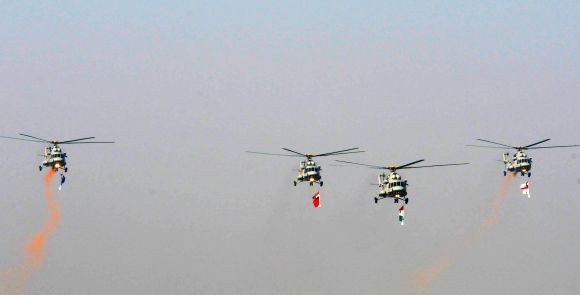 This year’s Republic Day parade in New Delhi, a traditional showcase for the country’s defence arsenal, featured an unusually large number of new military systems. At the very start, four brand new Mi-17V5 helicopters flew past, carrying the national flag.
This year’s Republic Day parade in New Delhi, a traditional showcase for the country’s defence arsenal, featured an unusually large number of new military systems. At the very start, four brand new Mi-17V5 helicopters flew past, carrying the national flag.
Followed by several other systems making a debut before the public. This is noteworthy, given the flak that the defence ministry has taken for endemic delays in procuring equipment for modernising the ageing military.
Now, after years of restructuring its procurement institutions and regulations, the MoD appears to be delivering much-needed weaponry to the three services.
The most eye-popping new system on display was the Agni-5 ballistic missile, which can carry a thermo-nuclear warhead to a target 5,000 km away. The giant 17.5-metre long, 50-tonne, three-stage missile rolled down Rajpath on a special launcher vehicle built by a private Indian company.
Built by the Defence R&D Organisation, it was successfully tested last April. After two or three more successful tests, it will join the Strategic Forces Command.
DRDO’s success in missile development was reflected in the awards won by three of its top scientists. V K Saraswat, its chief and scientific advisor to the defence minister, a key member of India’s missile development programmes for decades, was awarded the Padma Bhushan. Avinash Chander, chief controller of missile development, was awarded a Padma Shri, as was Sivathanu Pillai who oversees the Brahmos cruise missile programme.
The Indian Air Force was relieved to display, though it was a scaled-down model, the Pilatus PC-7 Mark II basic trainer aircraft. It was recently procured from Swiss manufacturer Pilatus for Rs 1,800 crore. With the IAF’s basic trainer fleet of HPT-32 Deepak aircraft grounded after the deaths of 19 pilots in 17 crashes, this will fill a crucial gap.
Also showcased on the IAF tableau was the C-17 Globemaster III, the purchase of which signalled that New Delhi was willing to pay big money for world-class systems. The IAF is paying Rs 22,800 crore for 10 of these, making it the largest operator of this transport aircraft outside the US.
Boeing will deliver the first five C-17s this year, with the next five in 2014. India is expected to place a follow-on order for this aircraft, which it needs for quickly reinforcing threatened sectors along the Himalayan northern border.
The C-17 can deliver 74 tonnes of stores to a km-long unpaved runway 4,500 km away.
Another expensive, new aircraft featured on the IAF tableau was the AW-101 AgustaWestland helicopter. MoD has bought 12 of these for Rs 3,550 crore, for VVIP transportation.
Delivery has begun, even as the Italian company is being investigated in its home country after allegations of bribes paid to facilitate this and other contracts.
Another new IAF display was the Airborne Early Warning and Control aircraft, which DRDO is developing. These indigenous airborne radars, mounted on Embraer executive jets, will greatly enhance the IAF’s ability to monitor Indian airspace and control the aerial battle.
The AEW&C will operate at an eighth of the cost of the Phalcon Airborne Warning & Control System, which the IAF currently uses.
Besides IAF, the Indian Navy showcased the warships it is inducting. Most prominent among these was the nuclear-propelled attack submarine, INS Chakra, displayed on the navy’s tableau.
The 12,000-tonne Chakra, which India has leased from Russia for 10 years for about Rs 4,800 crore, joined the eastern naval fleet in April. With virtually unlimited operating endurance, the Chakra greatly strengthens the navy’s ability to stop enemy shipping at Indian Ocean choke points like the Strait of Malacca.
Also displayed on the naval tableau, though not yet delivered, was aircraft carrier INS Vikramaditya, formerly the Admiral Gorshkov in the Russian navy. This jinxed vessel was bought in 2004 for Rs 5,000 crore and was to be delivered in 2008.
By last year, the price was up to Rs 12,500 crore. Close to delivery, the vessel’s engine boilers failed during final sea trials last September, leading to a delay of about a year. MoD says Vikramaditya ‘will join the naval fleet by the end of this year’.
Meanwhile, Russia has begun delivering to the navy the 19 MiG-29K/KUB fighters that will fly from the Vikramaditya. A follow-on order for 26 more Mig-29K/KUB has been placed.
Next year’s R-Day parade could feature two more crucial aircraft. First, the navy’s P8I Multi-Role Maritime Aircraft that will enhance ‘maritime domain awareness’ over India’s 2.54 million sq km of Exclusive Economic Zone.
The second could be the Rafale medium multi-role combat aircraft, the purchase of which is being negotiated with Dassault of France. It is expected that negotiations will be concluded by mid-2013. While the first Rafale, which Dassault would deliver in flyaway condition, can only be expected by 2015, the IAF tableau would certainly feature the Rafale if the contract is signed this year.
The army’s presence, as always, mainly took the form of marching infantry contingents, a colourful and impressive sight. Given the army’s relatively sluggish procurement machinery, it had little to display by way of new equipment.
There are plans for upgrading the soldier’s personal equipment, weaponry and clothing but for now, the army remains predominantly a light infantry force, consisting mainly of lightly equipped foot soldiers that can operate across thousands of miles of high-altitude mountain border.










